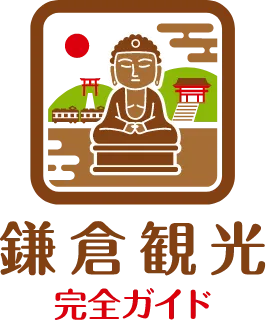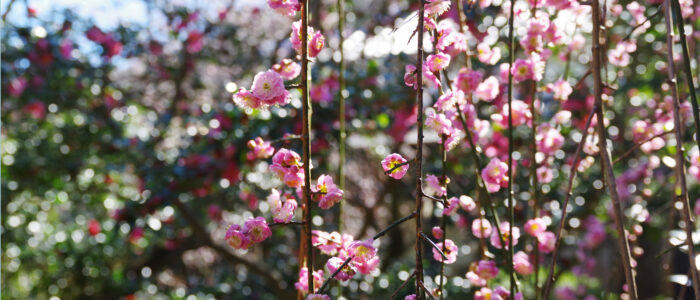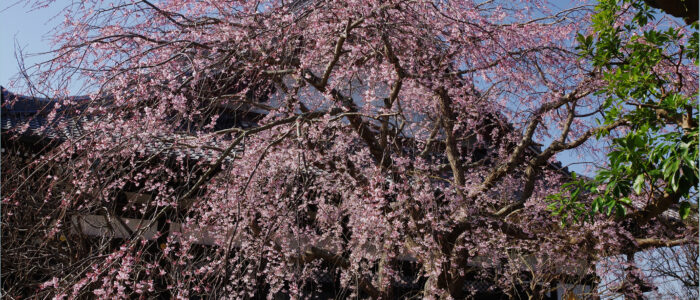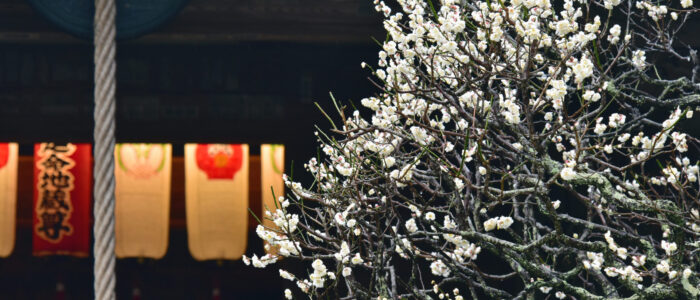Plum Blossoms at Hokai-ji Temple
The Beauty of Plum Blossoms at Hokai-ji
Hokai-ji Temple is a renowned spot in Kamakura where various plum trees, including weeping plums, red plums, white plums, and the unique “Omoi-no-mama,” which produces both red and white flowers on a single tree, bloom in harmony. The weeping plum, standing strong despite typhoon damage and salt exposure, is a striking symbol of spring’s arrival, captivating visitors with its elegant presence.
History and Background
Hokai-ji (宝戒寺) was founded in the early 14th century as a Tendai sect temple to honor the memory of Hojo Takatoki. While it is well known as the “Hagi Temple” (Bush Clover Temple) due to its famous autumn flowers, in spring, its diverse array of plum blossoms adds vibrant color to the temple grounds.
Best Season to Visit and Highlights
- Mid-February to Mid-March: Red, white, and weeping plums bloom in sequence.
- Mid-March Onward: Weeping plums reach their peak, displaying their most stunning beauty.
- “Omoi-no-mama”: A rare tree with both red and white blossoms, offering a different spectacle each year.
Plum Blossoms Around the Temple
Around 30 plum trees are scattered throughout the temple grounds, with notable concentrations in front of the main hall and around the Daisho Kankiten Hall. Among them, the weeping plum on the left side of the main hall is a must-see. Particularly impressive is the “Soei Plum,” a magnificent weeping plum tree measuring 5–6 meters in height and spreading over 10 meters wide, making it one of the most stunning plum trees in Kamakura.
Checking Plum Blooming Status
Observing the plum trees near the entrance is a good way to gauge the overall bloom status within the temple grounds. Since weeping plums tend to reach full bloom after other plums start shedding their petals, visiting after March 15 is highly recommended for the best viewing experience.
Access and Crowds
Hokai-ji is conveniently located just a 3-minute walk from Tsurugaoka Hachimangu Shrine, making it a popular stop on the Kamakura-Enoshima Seven Lucky Gods pilgrimage. While weekends can be crowded, weekdays offer a more relaxed viewing experience, making them ideal for visitors looking to enjoy the plum blossoms in a serene setting.
Conclusion
For a peaceful springtime experience, visit Hokai-ji Temple and immerse yourself in the beauty of its diverse plum blossoms against a backdrop of historical elegance.
Toshi’s Evaluation
| Evaluation Criteria | Score | Reason |
|---|---|---|
| Scenic Beauty | 9 points | The temple grounds feature around 30 plum trees, with the famous “Sōen Plum,” a weeping plum, being particularly stunning when in full bloom. The red and white plum blossoms, as well as the unique “Omoinomama” variety, add to its charm. |
| Accessibility | 9 points | Located a 15-minute walk from Kamakura Station and just 3 minutes from Tsurugaoka Hachimangū, it is easily accessible and fits well into sightseeing routes. |
| Historical Value | 8 points | Built under the order of Emperor Go-Daigo, the temple has significant historical value as it was established to honor the spirits of the Hōjō clan. However, its national recognition is somewhat limited. |
| Comfort | 7 points | While weekdays are relatively comfortable, weekends can be crowded. The facilities are adequate but not particularly noteworthy. |
| Reviews | 8 points | Online reviews are generally positive, with visitors praising the beauty of the plum blossoms. However, some mention issues with crowding. |
Total Score: 41 Points
Hōkaiji is a highly attractive destination known for its plum blossoms, especially the “Sōen Plum” and other unique varieties. Its accessibility and historical background are strong points, though there is room for improvement in terms of comfort during peak times and broader national recognition.




